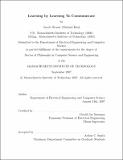Learning by learning to communicate
Author(s)
Beal, Jacob Stuart Michael
DownloadFull printable version (2.807Mb)
Other Contributors
Massachusetts Institute of Technology. Dept. of Electrical Engineering and Computer Science.
Advisor
Gerald Jay Sussman.
Terms of use
Metadata
Show full item recordAbstract
Human intelligence is a product of cooperation among many different specialists. Much of this cooperation must be learned, but we do not yet have a mechanism that explains how this might happen for the "high-level" agile cooperation that permeates our daily lives. I propose that the various specialists learn to cooperate by learning to communicate, basing this proposal on the phenomenon of communication bootstrapping, in which shared experiences form a basis for agreement on a system of signals. In this dissertation, I lay out a roadmap for investigating this hypothesis, identifying problems that must be overcome in order to understand the capabilities of communication bootstrapping and in order to test whether it is exploited by human intelligence. I then demonstrate progress along the course of investigation laid out in my roadmap: * I establish a measure of developmental cost that allows me to eliminate many possible designs * I develop a method of engineering devices for use in models of intelligence, including characterizing their behavior under a wide variety of conditions and compensating for their misbehavior using failure simplification. * I develop mechanisms that reliably produce communication bootstrapping such that it can be used to connect specialists in an engineered system. * I construct a demonstration system including a simulated world and pair of observers that learn world dynamics via communication bootstrapping.
Description
Thesis (Ph. D.)--Massachusetts Institute of Technology, Dept. of Electrical Engineering and Computer Science, 2007. This electronic version was submitted by the student author. The certified thesis is available in the Institute Archives and Special Collections. Includes bibliographical references (p. 215-218).
Date issued
2007Department
Massachusetts Institute of Technology. Department of Electrical Engineering and Computer SciencePublisher
Massachusetts Institute of Technology
Keywords
Electrical Engineering and Computer Science.